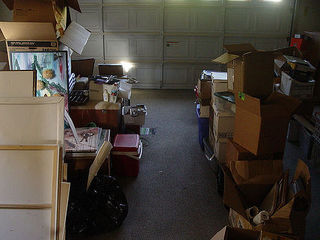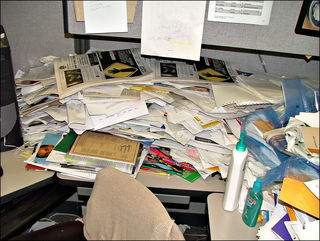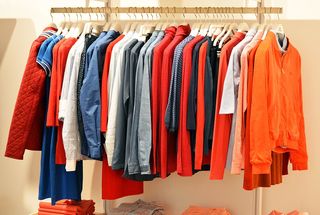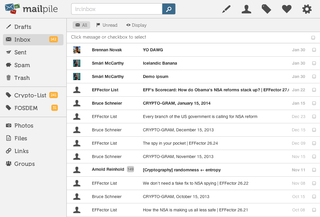Guilt
Four Organizing "Sins" to Start Committing on Purpose
Here's why you might already be more organized than you think.
Posted October 31, 2017

Computer science gets blamed for much of our modern psychological pain. Its obsession with automation has made our careers more precarious. Its success in connecting all of us together has also increased our anxiety by putting us into competition with the very best providers of our skills and services in the whole world. And its gadgetry often trains our attention away from the flesh and blood others in the room and toward its many screens.
On the bright side, it has made us more productive, has connected us more tightly with distant friends and family, and has vastly increased our entertainment options.
And computer science has also provided another, less obvious, consolation prize. It can help us reduce the amount of guilt we feel as a result of being disorganized, and it can do this in at least two ways.
First, computer scientists have discovered that some of our "laziest" organizing habits are actually pretty close to optimal. And that means we can continue being lazy, but without all the guilt!
And second, in some of the places where we could stand to be better organized, we can use some of their super simple data storage and retrieval tricks.
Here are four organizing "sins" we should worry less about and perhaps even start committing on purpose:
1. Boxes in your garage, attic, or basement

Many of us have boxes in our garages, attics, or basements. And we feel guilty about it. And seriously, why are we holding on to that stuff? And what's even in those boxes?
Computer science tells us to relax. Having boxes in our garages is far better than having all that stuff in our living spaces. And it's probably not hurting anything just sitting there.
Keeping a box of miscellaneous stuff in the garage is what computer scientists would call a "caching" technique. A "cache" is just a place to store things. And caches are used to make data storage and retrieval faster overall.
In the case of a computer, the larger its working memory is, the longer it takes to search through that working memory to find the things it needs. But the smaller the working memory is, the less likely it will be that the needed information will be in working memory.
It's a good old-fashioned trade-off. And computer scientists have made the best of this trade-off by using something called multi-tiered caching. They keep working memory fairly small, so it can be lightning fast, yet big enough that most of the most commonly needed information is there.
Then they'll store the information that's used a bit less frequently (but still somewhat often) in a bigger (and somewhat slower) cache.
And information that's rarely needed can be stored in a very large cache (the hard drive). When you need something from that very large cache, it will take a while (in computer time) to find what you need, but the hope is that this won't happen very often.
Many computers have 5 or 6 levels of caching in order to improve storage and retrieval times.
Likewise, we can think of the boxes in our garage as a level of caching for our stuff. It's for the stuff we might or might not need over the course of the next year or two. If we do need something in one of those boxes, it might take a while (in human time) to find it, but, if we don't need those things very often, it won't be that much of a hassle overall. And the dirty little secret most of us know is that we rarely need to access the things in those boxes in our garages.
The practice of keeping a box or two or 10 in the garage has two big benefits.
First, if we feel free to put stuff in boxes in our garage, it can reduce the number of things we have in our living and working spaces, which means it will be that much easier to manage the stuff that matters most.
Second, this practice makes it easier to make choices as we de-clutter. If you follow the Getting Things Done method of de-cluttering, you'll basically do one of three things with each item: 1) keep it in the living/working space, 2) get rid of it, 3) store it in a someday/maybe or maybe later area. (David Allen's flowchart for processing an inbox is more complicated than my gloss, but it can be refactored to this simpler version for many purposes.)
Some organizing experts don't agree with this. They say you should only touch things once (OTTO), and either put something in its place or toss it out.
But OTTO can turn a decluttering session into a long bout of agonizing decision-making. And it can lead to regret if we toss something and later realize we need it.
A better rule (if you have space) is: "If in doubt, put it in a box in the garage." This makes de-cluttering super simple. If it's an obvious keep, put it away. If it's obvious trash, throw it out. Otherwise, put it in a box in the garage.
Now, eventually, you'll want to get rid of some of those boxes in the garage. But that's easy, too. Start with the one that's been there the longest (maybe two to three years), and go through it. Chances are, you'll almost instantly decide to get rid of 90 percent of it. Maybe you'll pull one or two sentimental items back into your living space. And you can dump the handful of items you're still not sure about into one of the other boxes in your garage.
Is this advice revolutionary? No. You were probably already doing it. But you were doing it with guilt. Now you can do it on purpose.
2. Piles of papers on your desk (or unsorted papers in a banker's box).

I used to collect documents such as bank statements, articles, owners manuals, and tax forms in an outbox and intend to file them away on perhaps a weekly basis. What eventually happened was that I put them in a banker's box which I processed maybe once per year, if that. And I always felt guilty about that unsorted box of documents and owners manuals sitting in the corner of my home office.
Today I do pretty much the same thing, but now I don't feel any guilt about it, because now I can justify it. Computer Science tells me that this behavior is actually pretty close to optimal.
Why is it close to optimal? You guessed it. It's a form of caching. But more than that, it's also a matter of the way it spontaneously organizes itself.
"It's not organized, it's just a pile," you say. Well, a pile is organized. And it's organized according to a remarkably efficient principle that Brian Christian and Tom Griffith's (and many other computer scientists) call "Least Recently Used" (LRU) (meaning the least recently used things sink to the bottom).
It doesn't happen very often, but sometimes I do need some of the things in the box. And I've discovered the same thing computer scientists discovered long ago. I don't know if there's a deep universal truth at work here, or if it's just a serendipitous feature of human nature, but the following seems to be true in a wide range of cases. If we know nothing other than the fact that we have an LRU stack, and that we need something from that stack, the most likely place to find that thing is on the very top. The next most likely place to find it is second from the top. And so on.
And that means tossing things on the top after you've used them is generally a remarkably efficient way to store things. When you search through a stack, you search one thing at a time down the stack. And it just so happens that the things we need are much more likely to be toward the top of the stack than the bottom. So search times are generally kept pretty low.
Now, if you go a full year between filing like I do (I use tax season as my trigger), you'll likely find that you didn't spend that much time searching for stuff in the box during the year, and you spent almost no time storing it. In fact, if you're like me, you will have spent far less time managing your paper documents than you would have, had you religiously filed things on a daily or weekly basis.
And here's another trick. When I do process my box, I turn the stack upside down. I find that it's easier to make decisions about what to do with the stuff I haven't touched for a year, than with the stuff that I've handled more recently. In fact, a good portion of the least recently used documents just get tossed in the trash. When I turn the stack upside down, I can process a good two-thirds of it in 10 or 20 minutes. And, if I'm feeling lazy, I can just turn the final one-third over again and put it back in the box ready to have new stuff placed on top of it. I can always process those documents next year.
Of course, your mileage might vary. I don't need to repeatedly access many documents. If you do, you might want to file a little more frequently.
3. "Disorganized" clothes in your closet (or books on your bookshelf)

Some organizing experts, like Martha Stewart, advise us to store "like with like" in our closets. Put your button-up shirts with your button-up shirts. Put your t-shirts with your t-shirts. Put your skirts with your skirts, your slacks with your slacks, and your jeans with your jeans.
Inevitably, a few weeks after organizing our clothes, the "like with like" scheme decays until we have some weird hybrid between organized and random. The same thing happens to our books on our bookshelves. And when the closet is not organized the way we think it should be, it can drive us nuts.
It turns out we can use the lesson from the last section to make organizing much easier. Christian and Griffiths tell us that, instead of grouping like with like, we can use a stack to organize our clothes and books. Except, this time, instead of a vertical stack, we will use a horizontal stack.
Once we get our clean laundry on hangers, instead of putting our button-up shirts with our button-up shirts, we'll just hang all of our newly cleaned clothes together at one end of our closet (the front, or the left, perhaps). And, over time, the clothes we wear most frequently will magically become concentrated toward the left or front end of the closet, and the clothes we never wear will magically move to the right or back of the closet.
Then, if we want to donate some clothes every year or so, we'll know right where to go to get the clothes we wish to donate—the right half or the back half of the rack.
Now, if your clothing choices are strongly seasonal, you might want to play with a different scheme. But for those who tend to wear similar clothes month in and month out, this super simple scheme is hard to beat.
If your goal is to spend less time storing and retrieving clothes (as opposed, say, to having friends "ooh" and "ahh" at how well organized your closet looks), then give LRU a try.
I'll leave it as an exercise for the reader to figure out how to use the same principle to organize books on a bookshelf.
4. "Disorganized" email.

Before Google launched Gmail, most of us took upon ourselves a very cumbersome duty, which we mostly failed to fulfill—organizing our email into folders. If you're still trying to sort your email into folders, let me try to talk you out of it.
Gmail encourages us to move any email we wish to keep into one big archive file, rather than a set of partitioned folders. In other words, Google is encouraging us to treat our email archive as one big box in the garage. It's just one big maybe-later file, but with the advantage that we can use a computer to search for the things in the box.
The only problem with this scheme seems to be that, if our email doesn't contain words that would be easy to remember to search for, we might have trouble finding it. Google's solution to that is to allow us to "tag" our document with a memorable hook. In a sense, tags are much like folders, but they're different in at least two important ways. First, we don't have to tag something to find it later. Second, we can use multiple tags for a single document.
Another guilt-inducing goal many people have is to get to "inbox zero."
There are some benefits to getting to inbox zero—it removes that nagging feeling that there might be an email in our inbox that we still need to reply to. But beyond that, it's not as crucial as some people might want us to think. Our inboxes are already fairly well organized by date of receipt.
And, if we do want to shrink the size of our inboxes periodically, then, again, it pays to turn the stack upside down, like we did with the banker's box full of documents. In this case, it means starting from the bottom of our inbox and working upward.
If we start from the bottom, we'll likely be able to simply delete or archive most of the emails at the bottom without any painful decision-making. (Think of all those reminder emails whose deadlines are long past.) We'll just delete and archive, delete and archive, and pull out that odd email we still need to do something about, and we'll be two-thirds of the way up the inbox in no time. Then it's up to us whether we want to get to inbox zero, or if we want to leave the 20 to 30 most recent emails in the inbox. (By now you can probably guess what I tend to do.)
Conclusion
So it turns out that, here and there, it pays to relax our organizing standards a bit. And it seems our energy-conserving lizard brains might know more than our culturally-sensitive neolithic brains do at times. We keep putting onerous organizing expectations on ourselves, and we feel guilty for not fulfilling these expectations. But our lazy lizard brains know better. And computer science can prove it.




